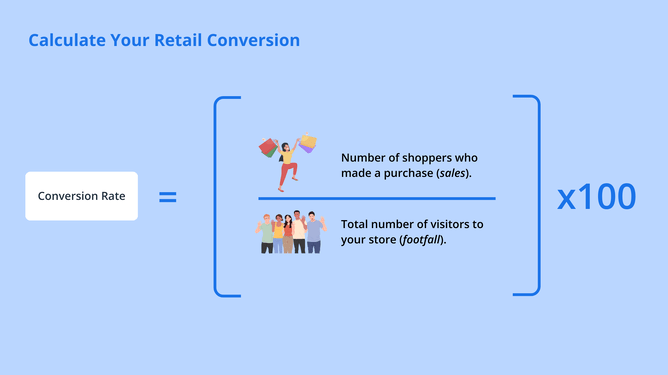Imagine this, a customer walks into your store, curious about what you offer. They have a look around, pick up a few pieces off the shelf, but ultimately leave empty handed.
Now picture that same customer… they come in to have a look around, pick up a few pieces off your shelves, except this time they leave with a full shopping bag, a smile and the promise to return and maybe even bring a friend.
What changed? The way you turned this customer's experience with your store into something special. It’s the in-store interaction that you or your shopfloors team provided, that meant this customer ultimately did make a purchase.
Improving conversion rate within your retail store, essentially translates to converting more browsers into buyers. Conversion is a crucial metric to monitor for true visibility into how your store is performing.
What is a Conversion Rate?
Conversion is the number of customers who purchased something from your store, divided by the number of shoppers overall.
If you’re working out your numbers now, remember times by 100 to get your percentage.
Why are conversion rates important in retail?
The really powerful thing about using conversion as a KPI for your retail store, is that it is demand weighted.
Monitoring conversion rate means it doesn’t matter how many people walked into your store, (although the more the better right? Don’t worry, we hear you!)
More importantly, what matters most is how many, out of all of those people, did your retail team actually sell something to or “convert”.
The key thing to understand with this retail KPI, is that you are not trying to sell something to every single person that comes in today, simply a percentage of them.
Increasing Your Retail Conversion Rates
Increasing conversion really does come down to a few different factors, but primarily it’s down to your retail team and their customer service skills.
Questions to ask yourself as a retail leader:
Is my retail team comfortable greeting customers?
Do they know when it’s suitable to re-approach a customer and strike up an interaction? If they do, are they friendly and approachable when chatting with your shoppers?
Do they have deep product knowledge? Or are there some gaps we need to close for them?
Are they confident closing a sale? Are they too pushy? Maybe too nervous?
It’s also important to check your store is delivering a super memorable experience in other more physical aspects as well.
For example strong promotions that pop out at your shoppers with competitive offers, interesting and strategic layouts for your merchandising, as well as getting back to the basics with great lighting, tunes and even smell.
Pro Tip: Give your fitting rooms a once over, a claustrophobic changing room with terrible overhead lighting is an absolute dealbreaker for your ideal conversion target.
Shifting the Goal Posts
As you monitor conversion rates over time and start to see that improvement. It’s important to stay vigilant and keep the pressure on.
Keep things playful and encourage a bit of healthy competition.
From here, wait for your team to hit their conversion goal for two weeks in a row, then dial things up a notch, increasing it by a few basis points to keep the heat on.
Overall while there are many factors to consider when approaching your conversion in-store, the driving force really is your team and their customer service skills.
If you’re interested in a retail selling framework that will equip your teams to sail through to closing their next sale effortlessly, check out our Resources page here.

